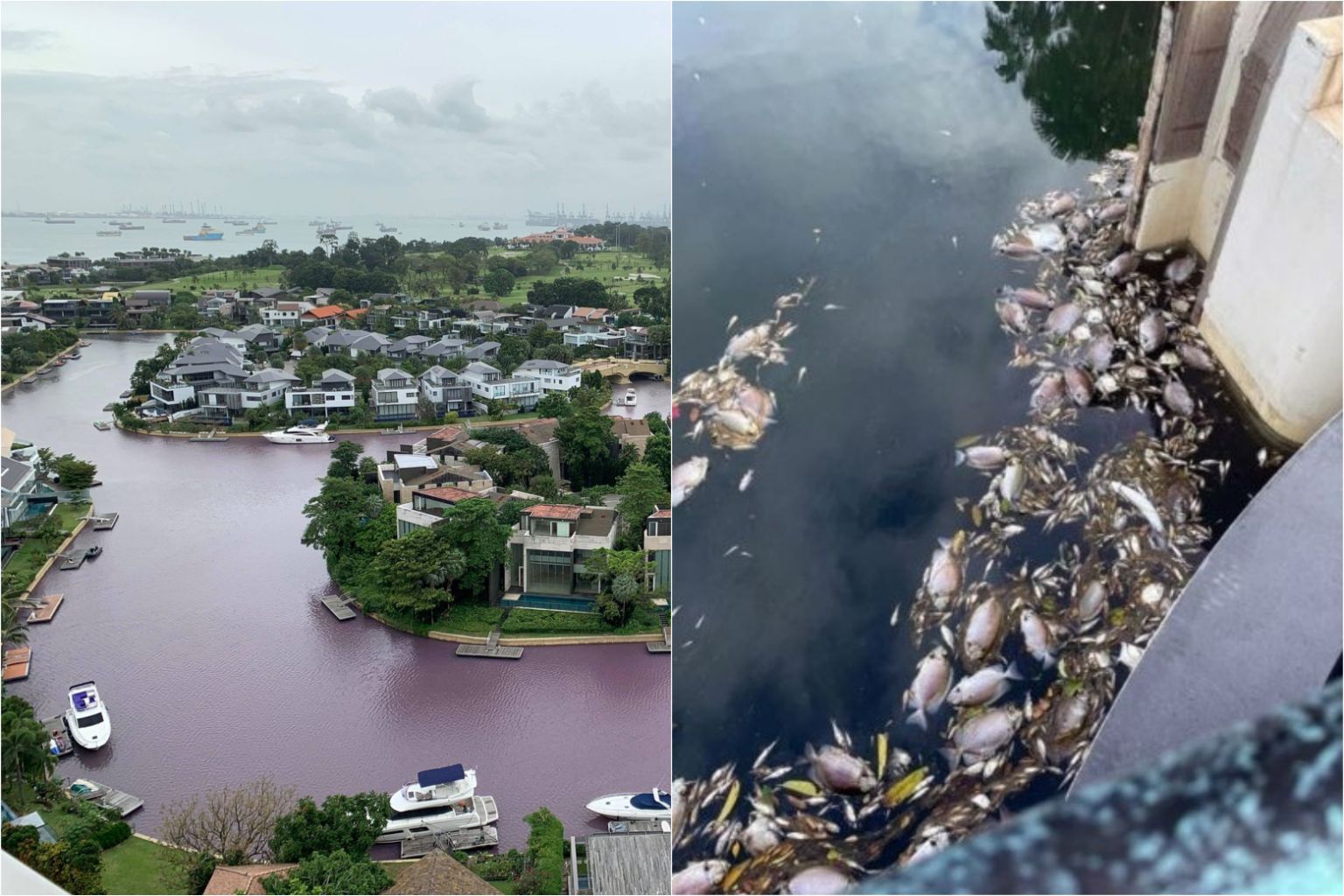Pinkish-purple water, dead fish in Sentosa South Cove waterway due to heavy rainfall altering water conditions
Sign up now: Get ST's newsletters delivered to your inbox

A portion of the waterway running through Sentosa South Cove turned pinkish-purple, after dead fish were found near the banks.
PHOTOS: SENTOSA COVE COMMUNITY, THE HERON OF THE GREEN BARRELS
Follow topic:
SINGAPORE - Investigations into the fish die-off and pinkish-purple colour of the Sentosa South Cove waterway earlier this month have found that it was caused by the recent weeks' heavy and persistent rainfall that altered water conditions.
Water samples tested had low levels of salinity and dissolved oxygen, which may have led to the dead fish sighted on the waterway banks from Jan 6 to Jan 9, said the Sentosa Development Corporation (SDC) and National Environment Agency (NEA) in a joint statement on Sunday (Jan 17).
The algal bloom that changed the colour of the waters was likely triggered by a high nutrient level and organic content in the water, NEA added.
Sentosa Cove residents first noticed a foul, sewage-like smell coming from the waterway on Jan 5. This was followed by the fish kill, and the waters turning shades of plum from Jan 12.
SDC and NEA, together with Sentosa Cove Resort Management (SCRM), studied water samples collected between Jan 6 and Jan 13.
The National University of Singapore's (NUS) Tropical Marine Science Institute (TMSI), which was tapped by SDC and SCRM, found high amounts of pico-cyanobacteria - a form of algae - in the water samples.
The colour of the bloom depends on the species of the algae and their pigment composition, and the algal bloom could have occurred even before the visible change in the colour of the waters, the SDC-NEA statement said.
In line with what experts told The Straits Times in earlier reports, TMSI's evaluation suggests that the dead fish could also be due to the low level of oxygen caused by the cyanobacteria's respiration or decomposition, or suffocation due to gill clogging. The statement added another possible cause - irritation caused by the algal bloom.
The unpleasant odour of the waters was likely due to decomposing fish, Sunday's statement added.

<p>pixfish15 / ST20210114_202138232365 / Alphonsus Chern // The purplish waters of the Sentosa South Cove waterway on 14 January 2021.</p>
PHOTO: ST
In a letter sent to residents on Jan 11 seen by The Straits Times, Knight Frank Property Asset Management on behalf of SCRM said the "largest clean-up and haul of dead fish" had been conducted.
Marine experts identified rabbitfish, moonfish, batfish and leatherjacket fish among the dead fish.
One resident, drama educator Ms Thi Lien Margaillan, who is in her forties, said that while there are no dead fish sightings along the waterway, the smell still lingers in the area.
Ms Thi Lien, who runs the environmental-interest group The Heron of the Green Barrels on Facebook, said that residents in the area were concerned about how the algae bloom affects the waterway.
"The water has yet to go back to normal and is now a muddy brown colour. As I live on a higher floor, the smell was not so unbearable, but I know residents living by the waterway will be affected if this happens again," she said.
TMSI senior research fellow Dr Sandric Leong said that heavy and regular rainfall causes the salinity of sea-surface water to decrease, and may also cause high-nutrient run off from land into the waterway. Rainwater, he added, was also a source of nutrients.
In response to queries, a spokesman for SDC said that surface run-off from the Sentosa Golf Club did not drain into the waterway, altering water conditions.
"As part of irrigation design, surface run-off from the Sentosa Golf Club's courses does not drain into the South Cove waterway. The lakes and fishes at the courses have also remained unaffected," she said.
Dr Leong said the algal bloom as a complex phenomenon caused by multiple factors such as light, nutrients and water movements. The cyanoboacteria's adaptability to sudden changes in environmental conditions like the recent continuous rainfalls enables it to out-compete other phytoplankton or algae, he added.
"Due to rainfalls, the light condition was low, cyanobacteria could grow better in low light level when compared to others," he said.
Dr Leong noted that algal bloom is a natural phenomenon that cannot be stopped or cleared away.
"The seawater and algal species need to be monitored regularly in order to minimise impact. It could happen again, when the right species is present with the optimal conditions for bloom formation," he said.
The statement on Sunday added that NEA and the National Parks Board would continue to assist SCRM on investigations and monitoring of the quality of waters in the South Cove waterway. As a precautionary measure, SCRM advised residents to continue to refrain from water sport activities in the waterway.

